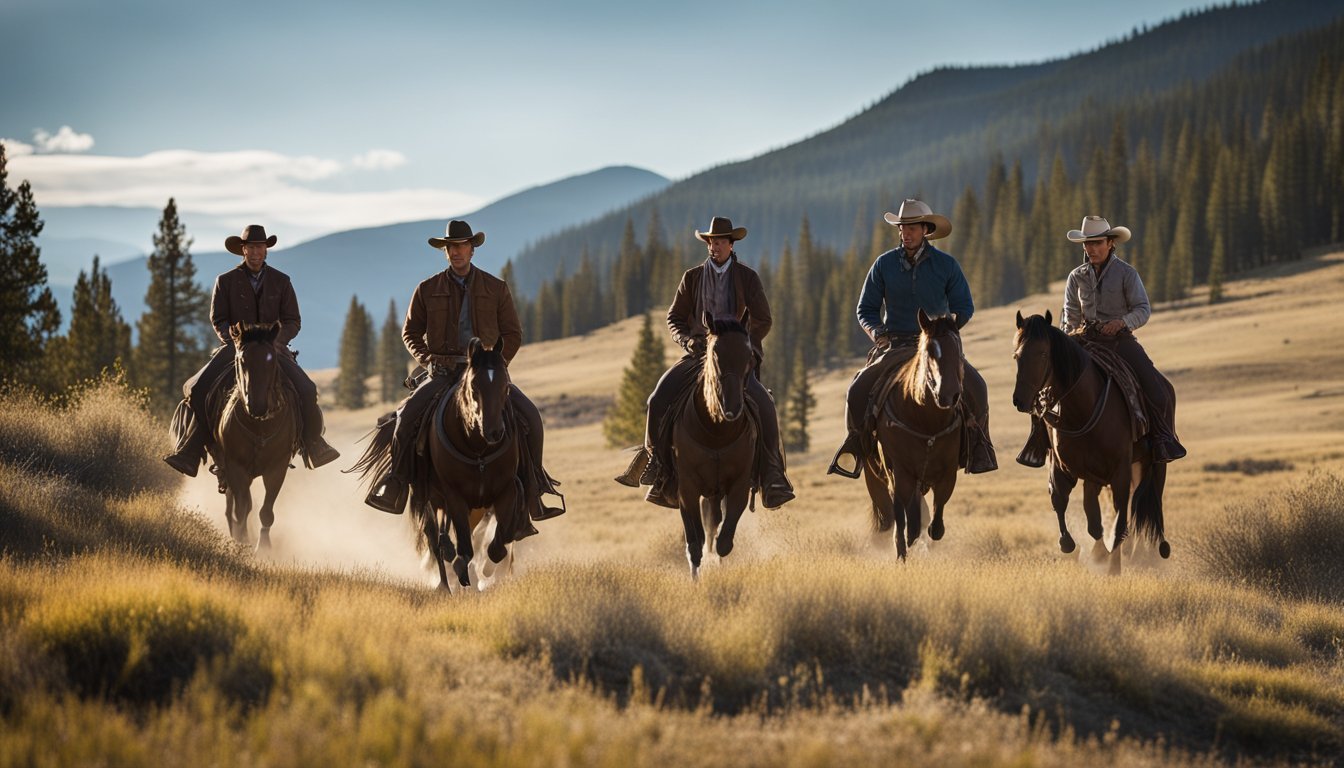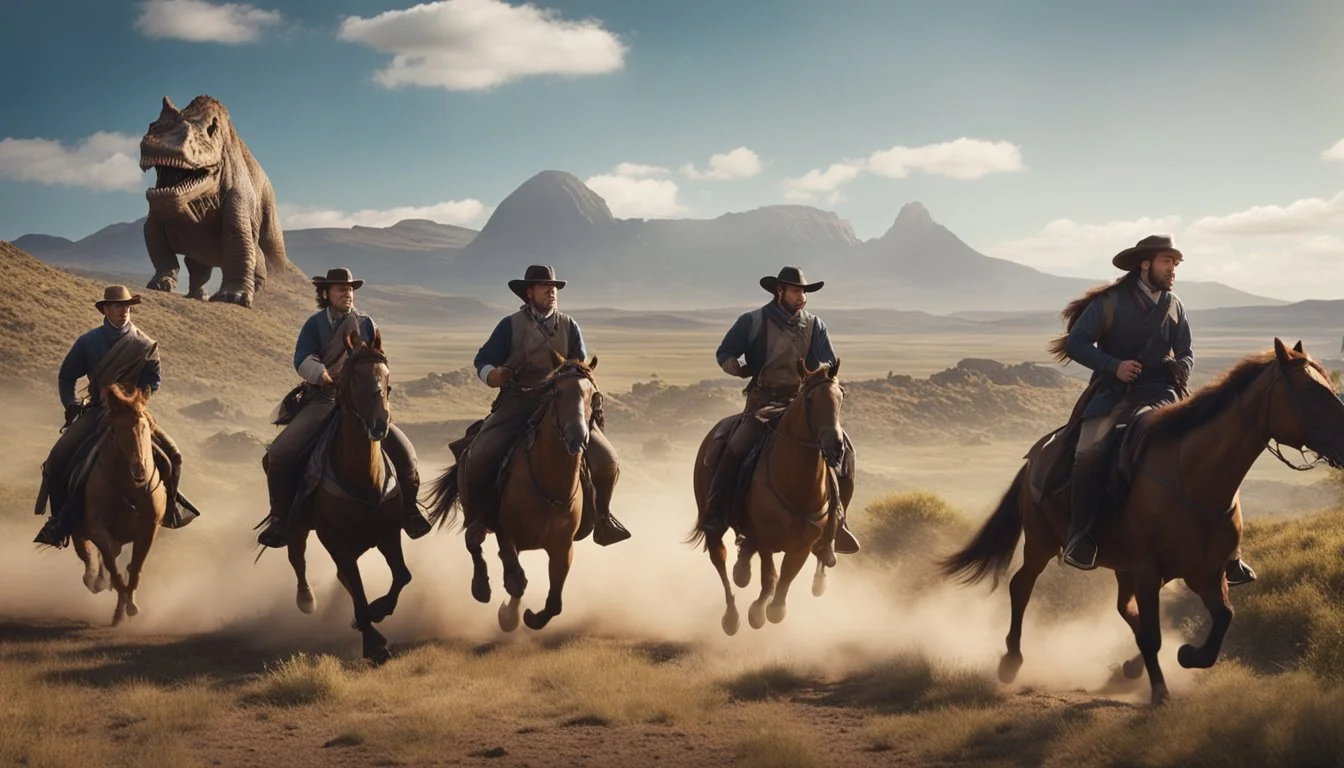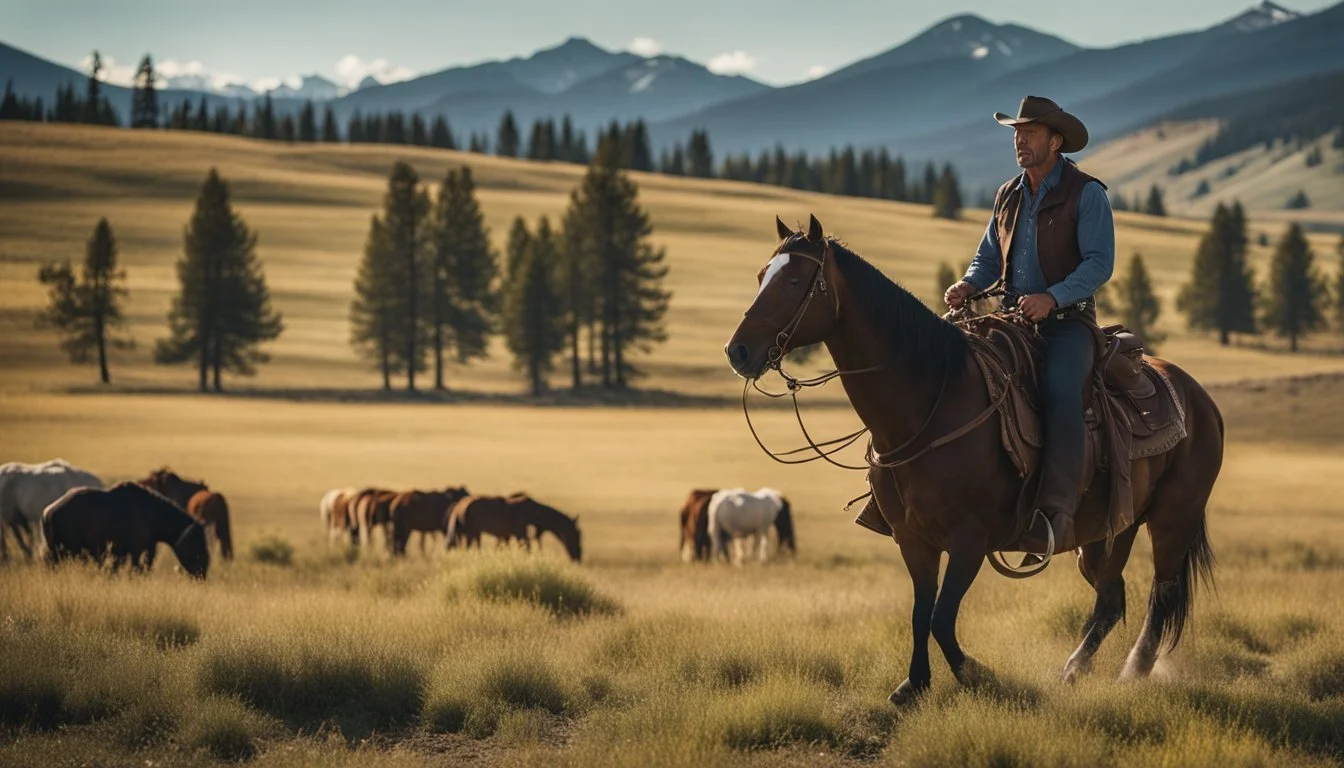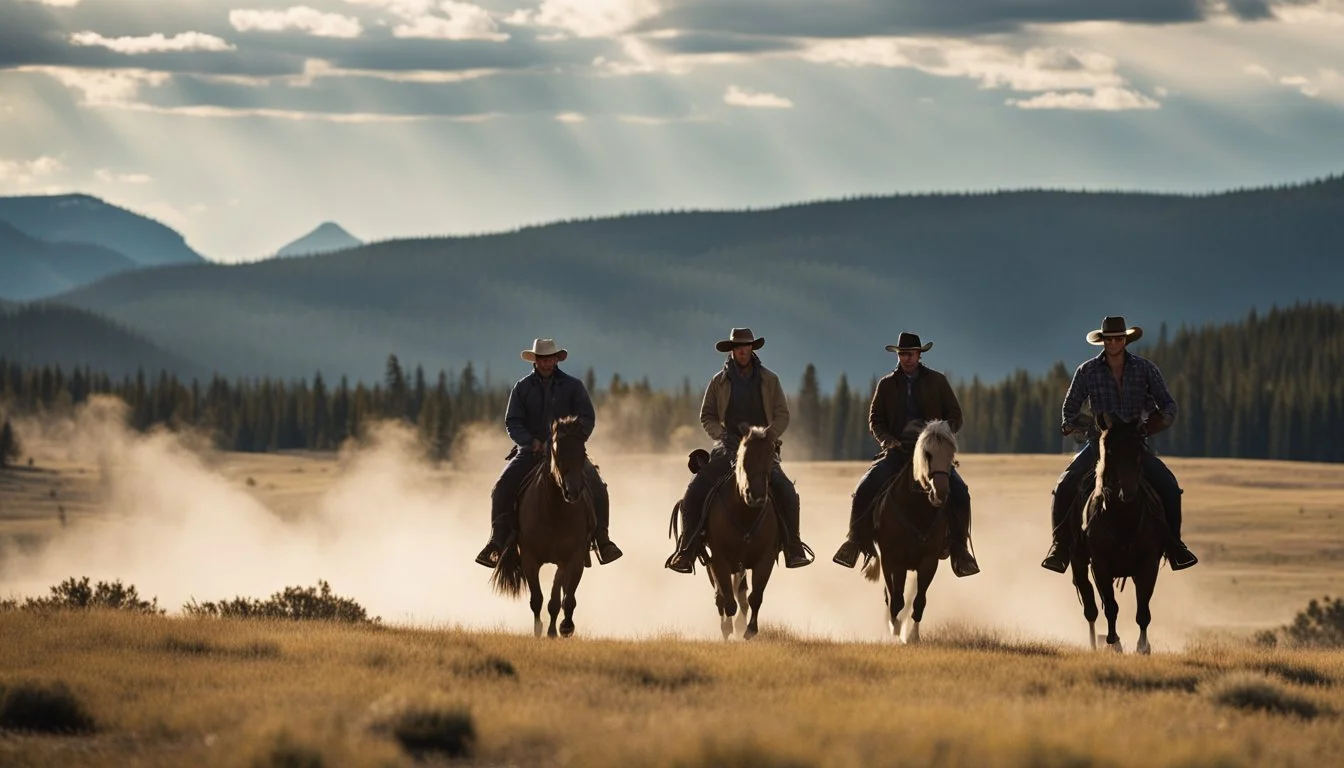Yellowstone Reimagined: Dinosaurs, Civil Wars, and Epic Ranching Battles Await!
Yellowstone, the hit television series created by Taylor Sheridan, has captivated audiences with its intense portrayal of the Dutton family's struggle to maintain control of their vast ranch. The show's modern-day setting provides a backdrop for exploring contemporary issues facing ranchers in the American West. Yet, the Yellowstone franchise has already demonstrated the richness of the Dutton family saga across different time periods through its spin-offs, 1883 and 1923.
Imagining Yellowstone set in a different era opens up intriguing possibilities for storytelling. The Dutton family's conflicts with land developers, politicians, and rival ranchers could take on new dimensions if placed against the backdrop of significant historical events. For instance, a Civil War-era Yellowstone might explore the family's efforts to establish their ranch amidst national turmoil, while a Great Depression setting could highlight the challenges of maintaining their legacy during economic hardship.
Shifting the time period would allow Taylor Sheridan to delve deeper into the Dutton family history, potentially revealing the origins of long-standing feuds or the acquisition of key parcels of land. It could also provide fresh perspectives on recurring themes in the Yellowstone franchise, such as the clash between tradition and progress, the importance of family loyalty, and the complex relationship between ranchers and Native American tribes.
Historical Context
The Yellowstone saga spans multiple eras of American history, from frontier settlements to modern political intrigue. Each period presents unique challenges and opportunities for the Dutton family as they strive to maintain their ranch and legacy.
Nineteenth Century Origins
The Dutton family's journey begins in the late 1800s during the era of westward expansion. James Dutton, the family patriarch, leads his clan from Texas to Montana in 1883. This period is marked by the aftermath of the Civil War and the push to settle the American frontier.
Montana's Paradise Valley becomes the Duttons' new home, a land rich in natural beauty but fraught with dangers. Native American conflicts, harsh winters, and the challenges of establishing a working ranch test the family's resolve.
The show could explore themes of manifest destiny, the displacement of indigenous peoples, and the birth of the American cattle industry.
Early Twentieth Century Challenges
As the 20th century dawns, the Dutton Ranch faces new hurdles. The 1923 timeline showcases Jacob Dutton's leadership during a tumultuous era. This period encompasses significant events like World War I, the 1918 influenza pandemic, and the onset of Prohibition.
Montana's economy shifts, with mining and timber industries competing with ranching. The Duttons must adapt to changing markets and technologies while defending their land from encroaching interests.
The series could delve into the modernization of the West, the rise of organized labor, and the impact of national policies on frontier life.
The World War Era
The mid-20th century brings global conflicts that reverberate through Montana. World War I and World War II draw young Duttons like Spencer away from the ranch to serve overseas.
On the home front, the Great Depression strains the ranch's finances. The family grapples with drought, economic hardship, and changing social dynamics.
This era could explore themes of national sacrifice, the evolution of American agriculture, and the tensions between tradition and progress on the frontier.
Contemporary Settings
The modern Yellowstone series, set in the early 21st century, presents a drastically changed landscape. John Dutton III fights to preserve his family's legacy against corporate interests, land developers, and the neighboring Broken Rock Reservation.
Political maneuvering takes center stage as John becomes Montana's governor. The ranch faces challenges from environmental regulations, changing demographics, and the tech industry's influence on the state.
This setting allows for exploration of current issues like land use conflicts, tribal sovereignty, and the clash between rural traditions and urban expansion in the American West.
Cultural and Societal Influence
Yellowstone's cultural impact stems from its portrayal of complex family dynamics, land ownership conflicts, and Indigenous representation. The show examines these themes through a modern lens, sparking discussions about contemporary American society.
Representing Indigenous People
Yellowstone brings Indigenous issues to the forefront through the Broken Rock Indian Reservation and Chief Thomas Rainwater. The series explores land rights, cultural preservation, and the challenges faced by Native communities. It highlights the ongoing struggle between tribal sovereignty and external pressures from developers and government entities.
The show's portrayal of Indigenous characters adds depth to the narrative, moving beyond stereotypes. Chief Rainwater emerges as a formidable leader, navigating complex political landscapes to protect his people's interests.
Yellowstone's depiction of Native American culture raises awareness about historical injustices and contemporary challenges. It prompts viewers to consider the complexities of Indigenous identity in modern America.
Exploring Family Dynamics
The Dutton family lies at the heart of Yellowstone's narrative, showcasing the intricacies of familial relationships in a high-stakes environment. Beth Dutton's fierce loyalty and Jamie Dutton's internal conflicts drive much of the drama.
Family ties are tested by external threats and internal power struggles. The loss of Evelyn Dutton shapes the family's dynamics, influencing decisions and relationships years later.
The show examines themes of legacy, loyalty, and betrayal within the family unit. It portrays the challenges of maintaining family bonds while navigating personal ambitions and external pressures.
Yellowstone's family drama resonates with viewers, reflecting universal themes of love, conflict, and generational differences.
Drama Among the Land Owners
Land ownership serves as a central conflict in Yellowstone, pitting the Dutton Ranch against various adversaries. The struggle to maintain control over vast tracts of land drives much of the series' tension.
Market Equities and other land developers represent the encroachment of outside interests on traditional ways of life. The show explores the clash between preservation and progress, highlighting the economic pressures facing rural communities.
Conservation easements become a tool in the fight to protect the land, adding legal complexity to the drama. The Beck Brothers embody the ruthless tactics employed in land disputes, escalating conflicts to dangerous levels.
Yellowstone's land ownership drama reflects real-world debates about resource management, development, and the changing face of the American West.
Character and Actor Portrayals
Yellowstone's rich characters and stellar performances are key to its success. The show's ability to create compelling personas across different time periods hinges on casting choices and nuanced portrayals.
The Pillars of Yellowstone
Kevin Costner's John Dutton anchors the modern-day Yellowstone as a stoic rancher fighting to preserve his legacy. His gravitas and complexity set the tone for the entire series.
In a different era, actors like Harrison Ford could embody an earlier Dutton patriarch, bringing a rugged determination to the role of a frontier settler.
Helen Mirren might portray a formidable matriarch, adding depth and authority to the Dutton lineage in a historical setting.
Legacy Characters
The Dutton family's multi-generational saga offers opportunities for actors to portray characters at various life stages.
James Dutton, played by Tim McGraw in the 1883 prequel, could be reimagined in different time periods, showcasing the family's evolving struggles.
Beth Dutton, a fan-favorite character, might be portrayed in her youth or as an elder, exploring her fierce loyalty and sharp wit across decades.
New Era Faces
A Yellowstone set in a different time could introduce fresh faces to capture the spirit of the era.
Matthew McConaughey might play a charismatic outsider challenging the Dutton's reign in a 1970s setting, bringing his trademark charm to the role.
Rising stars could portray young ranch hands or rival family members, injecting new energy into the Yellowstone universe.
Supporting Roles and Relationships
Rip Wheeler's unwavering loyalty to the Duttons could be explored in various historical contexts, from the Wild West to the Great Depression.
Jamie Dutton's complex relationship with his adoptive family might take on new dimensions in different social and political climates.
Native American characters could be portrayed with greater depth and historical accuracy, highlighting changing dynamics with the Dutton ranch over time.
Supporting actors would need to adapt their performances to reflect the social norms and challenges of the chosen era, maintaining the show's trademark intensity.
Yellowstone Spinoff Exploration
The Yellowstone universe has expanded beyond the original series, delving into different time periods and locations to explore the rich history of the Dutton family and the American West. These spinoffs offer unique perspectives on the characters and events that shaped the Yellowstone ranch.
1883: The Original Duttons
"1883" takes viewers back to the roots of the Dutton family saga. This prequel series follows James and Margaret Dutton as they embark on a perilous journey from Texas to Montana. Tim McGraw and Faith Hill portray the Dutton ancestors, with Sam Elliott joining the cast as a seasoned cowboy.
The show depicts the harsh realities of 19th-century frontier life. It explores themes of survival, family, and the American dream against the backdrop of a changing nation. "1883" provides crucial context for understanding the Dutton family's deep connection to their land.
Paramount+ released the series, further expanding the Yellowstone universe beyond the original Paramount Network show.
1923: The Next Generation
Set in the early 20th century, "1923" continues the Dutton family story. This spinoff stars Harrison Ford as Jacob Dutton and Helen Mirren as Cara Dutton. The series explores the challenges faced by the family during a time of significant historical events.
"1923" tackles issues such as Prohibition, the Great Depression, and the aftermath of World War I. It sheds light on how these events impacted the Dutton ranch and the surrounding communities.
The show provides a bridge between "1883" and the modern-day Yellowstone series, offering insights into the family's enduring legacy.
6666: Four Sixes Ranch
"6666" shifts the focus from Montana to Texas, centering on the historic Four Sixes Ranch. This modern-day spinoff explores the operations of one of the largest and most prestigious ranches in the United States.
The series promises to showcase the daily lives of cowboys working on the ranch, blending traditional ranching practices with modern technology. It aims to provide an authentic portrayal of contemporary ranch life in Texas.
"6666" represents a departure from the Dutton family storyline while still maintaining connections to the broader Yellowstone universe.
Lawmen: Bass Reeves Story
"Lawmen: Bass Reeves Story" expands the Yellowstone universe by focusing on a historical figure unrelated to the Dutton family. This spinoff tells the story of Bass Reeves, the first Black deputy U.S. marshal west of the Mississippi River.
The series explores Reeves' life and career, highlighting his contributions to law enforcement in the American West. It delves into the challenges he faced as a Black lawman in the post-Civil War era.
While not directly connected to the Dutton saga, this spinoff adds depth to the portrayal of the American frontier in the Yellowstone universe.
Evolution of the Yellowstone Series
The Yellowstone series has undergone significant transformations since its debut, expanding its narrative scope and exploring various time periods. Character development, thematic depth, and visual storytelling have all played crucial roles in the show's evolution.
Seasonal Developments
Season 1 introduced the Dutton family and their struggles to maintain control of the Yellowstone Ranch. As the series progressed, Season 2 delved deeper into family dynamics and external threats.
Season 4 marked a turning point, with increased focus on land development conflicts and the Broken Rock Reservation. Season 5 expanded the narrative scope, exploring conservation issues and political ambitions.
The introduction of spin-offs like "1883" and "1923" allowed the franchise to explore different eras of the Dutton legacy. These prequels provided historical context to the modern-day conflicts depicted in the main series.
Series-Wide Themes
Yellowstone consistently explores themes of family loyalty, power struggles, and the clash between tradition and progress. The preservation of the Dutton's way of life against encroaching modernity remains a central conflict.
Land ownership and stewardship are recurring motifs, with the series examining the complex relationships between ranchers, Native Americans, and government entities. The show also tackles issues of environmental conservation and the impact of tourism on the region.
Cultural identity plays a significant role, with the series portraying the intersection of cowboy culture, Native American traditions, and modern American society. The concept of legacy and the weight of seven generations of family history frequently influences character decisions and plot developments.
Filming Locations and Visuals
Yellowstone's visual aesthetic has been a key factor in its success. The series primarily films in Montana's Paradise Valley, capturing the breathtaking landscapes of the American West.
The show's cinematography emphasizes wide, sweeping shots of mountain ranges, prairies, and rivers. These visuals serve not just as a backdrop but as a character in their own right, underscoring the importance of the land to the story.
As the series progressed, it expanded its filming locations to include areas in Texas, particularly for scenes set at the 6666 Ranch. This visual diversity reflects the expanding scope of the Yellowstone universe and the characters' journeys beyond Montana.
Influence on Popular Culture
Yellowstone has had a significant impact on popular culture, revitalizing interest in Western-themed entertainment. The show's portrayal of modern ranch life has influenced fashion trends, with cowboy hats and Western wear seeing increased popularity.
The series has sparked renewed interest in ranch tourism and horseback riding experiences. It has also drawn attention to real-world issues facing the American West, such as land use conflicts and conservation efforts.
Yellowstone's success on cable and streaming platforms like Paramount+ has influenced the television industry, demonstrating the viability of neo-Western dramas. The show's expansion into a franchise with multiple spin-offs has set a new standard for universe-building in television series.






